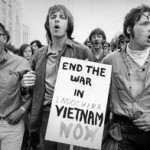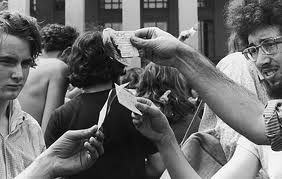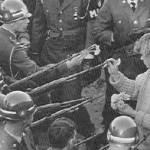Why was Vietnam a so heavily divided subject amongst the American People?
 Vietnam was the first publically accessible war to the American public. With the invention of the television and the constant media exposure, for the first time the horrors of war was a publically accessible domain. Due to this, a ‘generation gap’ was created, creating two sides; those who had matured during WWII and those that had matured during Vietnam. Generally, the older citizens were for Vietnam and the younger citizens were anti-Vietnam. Furthermore, the country became more anti-Vietnam after the casualty numbers started to roll in, Nixon started to lie, the draft was announced and TV was clearly showing that Vietnam “was invalid, badly executed, wasteful, vicious, and ugly” (Kim Herzinger) Vietnam is (to this date) one of the most publically opposed wars in history. Vietnam spanned 5 Presidents; however, it only started to really heat up when Johnson took office and began to ‘crack down’ on ‘Nam.
Vietnam was the first publically accessible war to the American public. With the invention of the television and the constant media exposure, for the first time the horrors of war was a publically accessible domain. Due to this, a ‘generation gap’ was created, creating two sides; those who had matured during WWII and those that had matured during Vietnam. Generally, the older citizens were for Vietnam and the younger citizens were anti-Vietnam. Furthermore, the country became more anti-Vietnam after the casualty numbers started to roll in, Nixon started to lie, the draft was announced and TV was clearly showing that Vietnam “was invalid, badly executed, wasteful, vicious, and ugly” (Kim Herzinger) Vietnam is (to this date) one of the most publically opposed wars in history. Vietnam spanned 5 Presidents; however, it only started to really heat up when Johnson took office and began to ‘crack down’ on ‘Nam.
Johnson
- (1967) 300 000 people marched in protest of the Vietnam War in New York City; 100 000 tried to close the Pentagon
- (1968) 221 major demonstrations were staged at more than 100 institutions
- As a result of the Gulf of Tonkin Incident, early August 1964, Johnson’s quick retaliatory response by way of air attack on North Vietnamese torpedo-boat bases and nearby oil tanks
- “…take all necessary measures to repel any armed attacks against the armed forces of the United States.” – Johnson, in a televised public address
- (August 5th, 1964) the Senate voted 98 to 2 in favour of the resolution he proposed -> unanimous approval
- Johnson’s approval ratings in the polls doubled overnight, just three months before the elections
Nixon
- Cambodia Incursion resulted in a series of protests in the U.S.
- Kent State Massacre: On May 4th, 1970, a crowd of students and demonstrators gathered at Kent State to protest the President’s decision to invade Cambodia
- The National Guard was on the scene and began to disperse the crowd by way of tear gas canisters and force
- Upon verbal command they fired a total of 67 shots were fired in 13 seconds. Four students: Allison Krause, Jeffrey Miller, Sandra Scheuer and William Schroeder were killed. Nine students were wounded.
Ford
- Unstable economy (due to Vietnam): Women paid less than men, consumer products not produced in tandem with war products, “vietnamization” also called “Nixon Doctrine”-> U.S. would only supply arms and money (replacing Americans with Vietnamese)
- Vietnam fell in 1975 -> all American troops pulled out by April 29, 1975; April 30, last helicopter left
The Draft; Conscription in the Vietnam War
- Draft was called “Selective Service”
- SS was introduced by FDR in 1940, and ran until 1973 when Ford changed the US military to a pure volunteer military
- “Draft Lotteries” were held to select the men who were drafted into the military
- The first draft lottery since 1942 was held on December 1, 1969
- Men excluded from the draft were those married (a section added in by Kennedy, “Kennedy’s Husbands”) or studying at university
- The re-institution of draft lotteries sparked MASSIVE protests and creative ways to avoid being drafted…
Draft Dodgers
Are you a young, relatively healthy American male? Don’t want to get shipped off to Vietnam? You have a few options:
1) Go to Canada
- Somewhere between 40,000 and 60,000 draft aged men fled to Canada to avoid the draft or for deserting the military
- Standard question: “Are you here to study? Excellent. Welcome to Canada.”
2) Apply for College (if you had no prior intentions to do so)
- All universities accepted draft-aged men and they were automatically granted a 50% on their courses to avoid being drafted
3) Apply for “conscientious objector” status
- On this list, really the only legal thing to do
4) Get married.
5) Burn your draft card proudly on the front lawn of General Hershey, the head of conscription
The Protests
- Protests were commonplace among all American universities (You weren’t cool if you didn’t have anti-Nam protests)

- The National Guard was called in on many occasions, and many protesters famously
Responded by placing flowers in the mouths of their guns
- 1967: March on NYC, March on the Pentagon
- 1970: Kent state massacre; Protests picked up even more greatly after this
General Hershey
- Gen. Hershey was the head of the draft board, and he became the subject of many, many, MANY anti-Nam protests
- In response to the massive protests, in October 1967, he issued the ‘Hershey Directive’, in which any draft-aged males seen protesting the war would be moved to the very top of the SS List
- There was a HUGE uproar to this, and the Supreme Court repealed it on January 2, 1970
- Nixon removed him from office shortly afterwards
